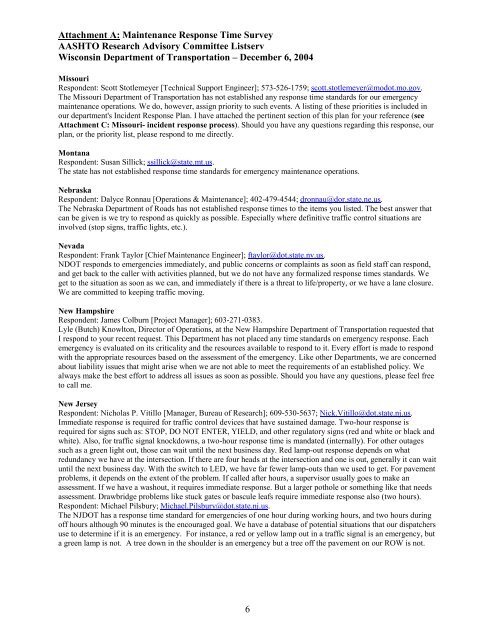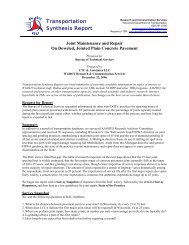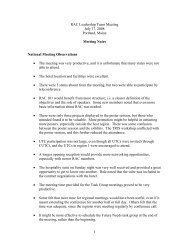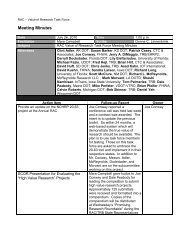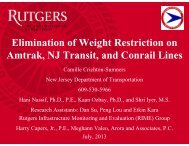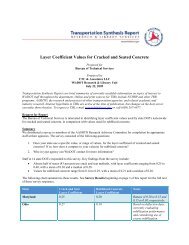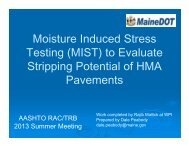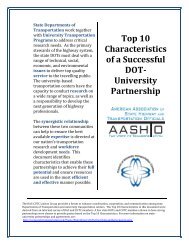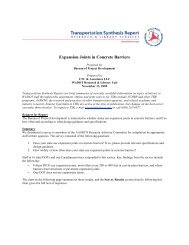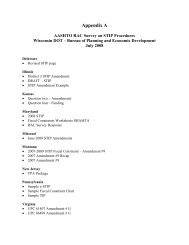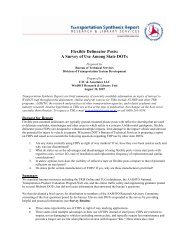Highway Maintenance Response Time Standards
Highway Maintenance Response Time Standards
Highway Maintenance Response Time Standards
You also want an ePaper? Increase the reach of your titles
YUMPU automatically turns print PDFs into web optimized ePapers that Google loves.
Attachment A: <strong>Maintenance</strong> <strong>Response</strong> <strong>Time</strong> SurveyAASHTO Research Advisory Committee ListservWisconsin Department of Transportation – December 6, 2004MissouriRespondent: Scott Stotlemeyer [Technical Support Engineer]; 573-526-1759; scott.stotlemeyer@modot.mo.gov.The Missouri Department of Transportation has not established any response time standards for our emergencymaintenance operations. We do, however, assign priority to such events. A listing of these priorities is included inour department's Incident <strong>Response</strong> Plan. I have attached the pertinent section of this plan for your reference (seeAttachment C: Missouri- incident response process). Should you have any questions regarding this response, ourplan, or the priority list, please respond to me directly.MontanaRespondent: Susan Sillick; ssillick@state.mt.us.The state has not established response time standards for emergency maintenance operations.NebraskaRespondent: Dalyce Ronnau [Operations & <strong>Maintenance</strong>]; 402-479-4544; dronnau@dor.state.ne.us.The Nebraska Department of Roads has not established response times to the items you listed. The best answer thatcan be given is we try to respond as quickly as possible. Especially where definitive traffic control situations areinvolved (stop signs, traffic lights, etc.).NevadaRespondent: Frank Taylor [Chief <strong>Maintenance</strong> Engineer]; ftaylor@dot.state.nv.us.NDOT responds to emergencies immediately, and public concerns or complaints as soon as field staff can respond,and get back to the caller with activities planned, but we do not have any formalized response times standards. Weget to the situation as soon as we can, and immediately if there is a threat to life/property, or we have a lane closure.We are committed to keeping traffic moving.New HampshireRespondent: James Colburn [Project Manager]; 603-271-0383.Lyle (Butch) Knowlton, Director of Operations, at the New Hampshire Department of Transportation requested thatI respond to your recent request. This Department has not placed any time standards on emergency response. Eachemergency is evaluated on its criticality and the resources available to respond to it. Every effort is made to respondwith the appropriate resources based on the assessment of the emergency. Like other Departments, we are concernedabout liability issues that might arise when we are not able to meet the requirements of an established policy. Wealways make the best effort to address all issues as soon as possible. Should you have any questions, please feel freeto call me.New JerseyRespondent: Nicholas P. Vitillo [Manager, Bureau of Research]; 609-530-5637; Nick.Vitillo@dot.state.nj.us.Immediate response is required for traffic control devices that have sustained damage. Two-hour response isrequired for signs such as: STOP, DO NOT ENTER, YIELD, and other regulatory signs (red and white or black andwhite). Also, for traffic signal knockdowns, a two-hour response time is mandated (internally). For other outagessuch as a green light out, those can wait until the next business day. Red lamp-out response depends on whatredundancy we have at the intersection. If there are four heads at the intersection and one is out, generally it can waituntil the next business day. With the switch to LED, we have far fewer lamp-outs than we used to get. For pavementproblems, it depends on the extent of the problem. If called after hours, a supervisor usually goes to make anassessment. If we have a washout, it requires immediate response. But a larger pothole or something like that needsassessment. Drawbridge problems like stuck gates or bascule leafs require immediate response also (two hours).Respondent: Michael Pilsbury; Michael.Pilsbury@dot.state.nj.us.The NJDOT has a response time standard for emergencies of one hour during working hours, and two hours duringoff hours although 90 minutes is the encouraged goal. We have a database of potential situations that our dispatchersuse to determine if it is an emergency. For instance, a red or yellow lamp out in a traffic signal is an emergency, buta green lamp is not. A tree down in the shoulder is an emergency but a tree off the pavement on our ROW is not.6


